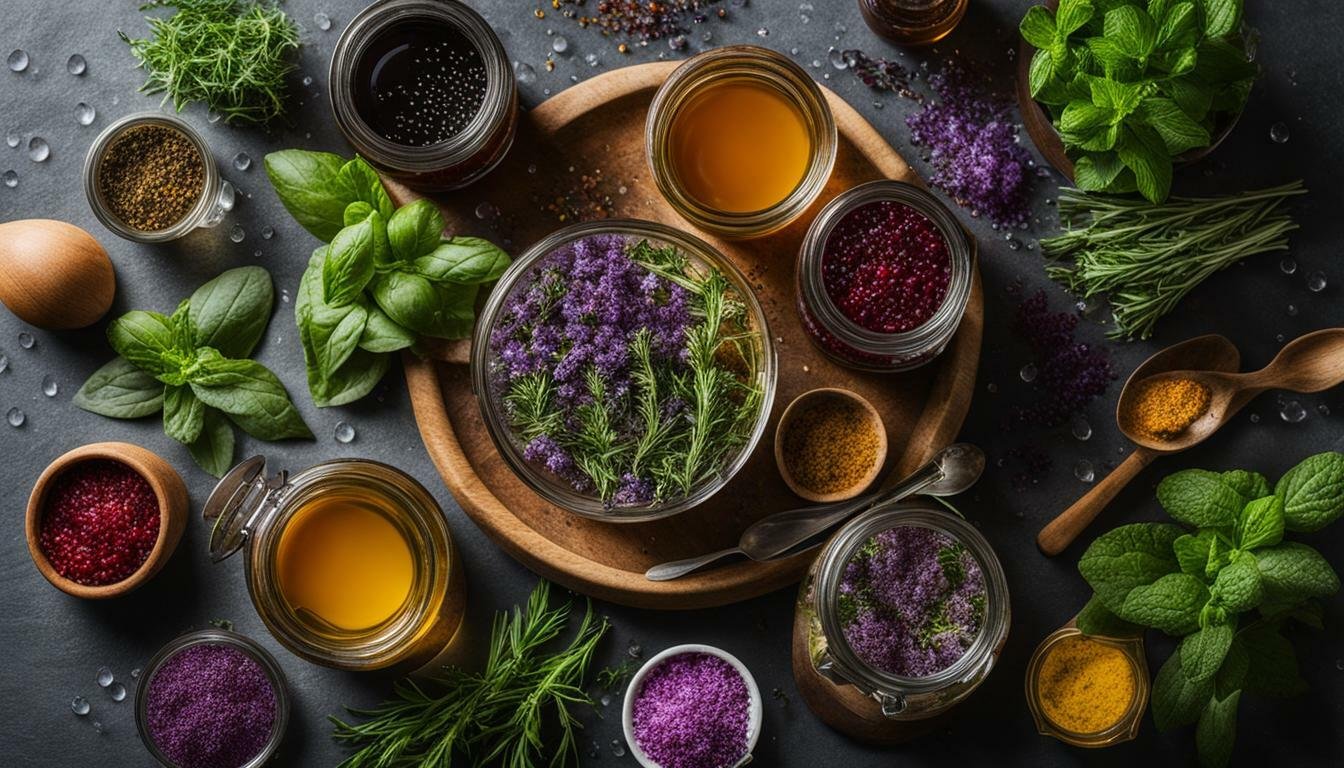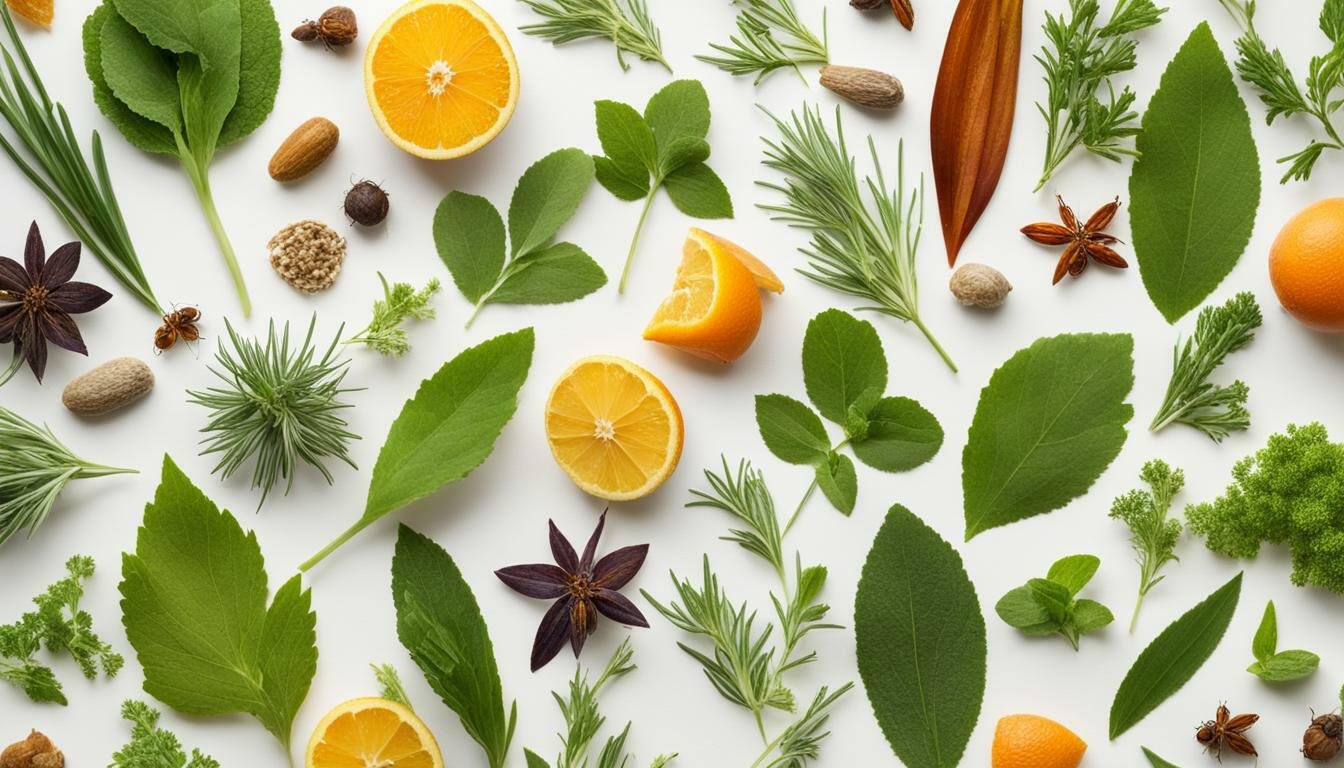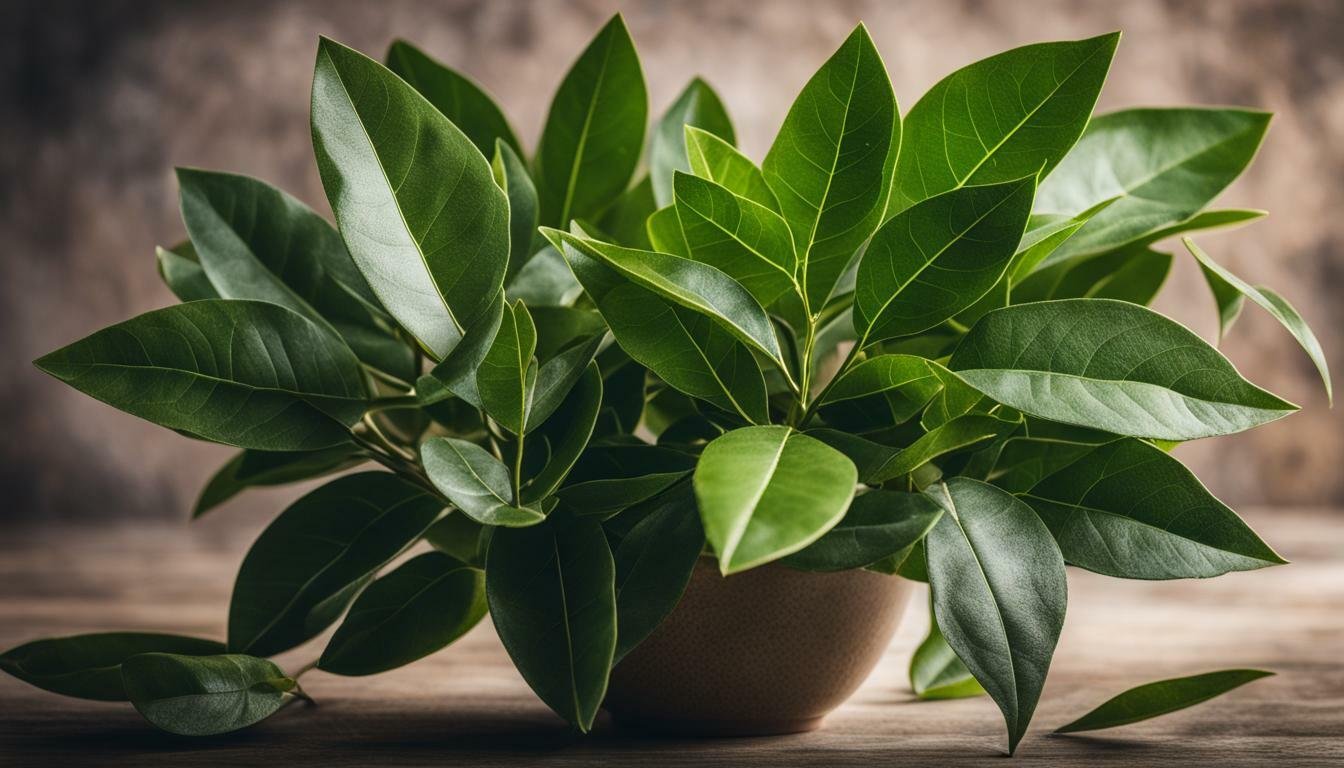Herbal Tinctures of Your Garden Herbs
Herbal tinctures are a wonderful way to utilize the medicinal properties of your garden herbs in the comfort of your own home. These concentrated herbal extracts are made using alcohol as a solvent, extracting the beneficial compounds from flowers, leaves, roots, barks, or berries. Whether you have fresh herbs right from your garden or dried ones on hand, making tinctures is a simple and effective method to harvest their healing potential.
- Tinctures are concentrated herbal extracts made using alcohol as a solvent.
- They can be made with fresh or dried garden herbs.
- Tinctures can be used as dietary supplements to support various wellness goals.
- Two main methods for making tinctures are the percolation method and the folk method.
- Proper storage, labeling, and periodic shaking are crucial during the tincture-making process.
Understanding Herbal Tinctures: Nature’s Concentrated Extracts
Herbal tinctures are concentrated extracts of herbs that serve as powerful medicinal remedies and dietary supplements. These extracts are made by using alcohol as a solvent to draw out the active compounds from various plant materials, including flowers, leaves, roots, barks, and berries. By harnessing the natural properties of these herbs, tinctures can be used to promote wellness and support a wide range of health goals.
Medicinally, herbal tinctures offer a convenient and efficient way to incorporate the benefits of herbs into our daily lives. They are easily absorbed by the body, allowing for quick and effective delivery of the herb’s medicinal properties. Whether used for immune support, stress reduction, or digestive health, herbal tinctures provide a concentrated dose of plant power in just a few drops.
As dietary supplements, herbal tinctures offer a natural and holistic approach to supporting overall wellness. They can be easily added to beverages or taken directly, providing an easy and convenient way to incorporate herbs into one’s daily routine. Whether you’re looking to boost energy levels, enhance cognitive function, or improve sleep quality, there is a wide variety of herbal tinctures to choose from to meet your specific wellness needs.
When it comes to making herbal tinctures, there are two main methods: the percolation method and the folk method. The percolation method involves a more complex process that requires specialized equipment, while the folk method is simpler and more accessible for home use. Both methods have their advantages and can produce high-quality tinctures, so it’s a matter of personal preference and available resources.
The Percolation Method:
In the percolation method, the herb material is packed into a column and the alcohol is gradually poured over it, allowing it to pass through and extract the desired compounds. This method is known for its efficiency and speed, making it a preferred choice for those looking to produce tinctures in larger quantities.
| Advantages | Disadvantages |
|---|---|
| Efficient extraction process | Requires specialized equipment |
| Quicker turnaround time | Less accessible for home use |
The Folk Method:
The folk method, on the other hand, involves a simpler process where the herb material is soaked in alcohol for an extended period, allowing for gradual extraction of the herbal compounds. While it may take longer, this method offers a more hands-on and intuitive approach to making tinctures.
| Advantages | Disadvantages |
|---|---|
| Accessible for home use | Slower extraction process |
| No specialized equipment required | Requires patience and time |
Regardless of the method chosen, the proportions of herbs and alcohol, as well as the strength of the alcohol used, play a vital role in the final product. Proper storage, shaking, straining, and labeling are also important steps to maintain the potency and quality of the tincture. It is highly recommended to consult a qualified medical professional before using herbal tinctures, especially if you have any underlying health conditions or are taking medications.
In conclusion, herbal tinctures are concentrated extracts of herbs that offer powerful medicinal benefits and serve as dietary supplements. Whether you prefer the percolation method or the folk method, making tinctures at home allows you to harness the natural healing properties of garden herbs. With proper preparation and storage, you can create high-quality tinctures that support your wellness goals and promote a healthy lifestyle.
The Two Methods: Percolation vs. Folk Method
When it comes to making herbal tinctures, there are two primary methods to choose from: the percolation method and the folk method. Both methods involve using alcohol as a solvent to extract the medicinal properties from garden herbs. Let’s take a closer look at each method and explore their advantages and disadvantages.
The Percolation Method
In the percolation method, the herb material is finely ground and packed into a percolator. Alcohol is then poured into the percolator and allowed to slowly drip through the herb, extracting the beneficial compounds. This method is known for its efficiency and speed, as the alcohol quickly permeates the herb material. The tincture produced using the percolation method often has a higher potency and a shorter extraction time compared to the folk method. However, it requires specialized equipment and may be more complicated for beginners.
The Folk Method
The folk method, on the other hand, is a simpler and more traditional approach to making herbal tinctures. In this method, the herb material is placed in a jar and covered with alcohol. The jar is then sealed and left to steep for several weeks or even months, allowing the alcohol to extract the medicinal compounds gradually. The folk method is favored by those who prefer a slower, more hands-on approach to tincture making. While it may take longer, the folk method requires fewer tools and is generally more accessible to beginners.
When deciding which method to use, it’s important to consider your personal preference, time constraints, and the specific herb you are working with. Some herbs may respond better to the percolation method, while others may benefit from the longer extraction period of the folk method. Experimenting with both methods can help you determine which one yields the best results for your desired tincture.
Summary
| Percolation Method | Folk Method |
|---|---|
| Efficient and quick | Slow and traditional |
| Requires specialized equipment | Accessible to beginners |
| Higher potency, shorter extraction time | Lower potency, longer extraction time |
Remember, the choice of herb proportions and alcohol strength will also play a role in the effectiveness of your tincture. Consulting reputable resources and seeking guidance from experienced herbalists can help ensure you achieve optimal results. With the right method, herb selection, and proper techniques, you can create your own herbal tinctures at home, harnessing the power of nature’s healing properties.
Choosing and Preparing Garden Herbs for Tincture Making
The success of your herbal tincture largely depends on the selection and preparation of the plant material you choose to use. Whether you opt for fresh or dried flowers, leaves, roots, barks, or berries, it’s important to ensure that you have high-quality, organic herbs. This will help you achieve the best possible results and maintain the potency of your tincture.
When it comes to selecting your herbs, consider the specific medicinal properties and flavors you desire. For example, if you’re looking for a tincture with calming properties, you may choose chamomile flowers. On the other hand, if you’re targeting respiratory health, you might opt for the soothing qualities of mullein leaves.
Once you’ve chosen your herbs, it’s time to prepare them for the extraction process. If you’re using fresh herbs, make sure to wash and dry them thoroughly. This helps remove any dirt or contaminants that could affect the quality of your tincture. If you’re using dried herbs, check for any signs of mold or decay and discard if necessary.
Now that your herbs are clean and ready, you can proceed with the tincture-making process. It’s important to note that the quantities of herbs and alcohol will vary depending on the specific herb and desired potency. It’s recommended to follow a reliable recipe or consult a trusted resource to ensure accurate proportions.
As you embark on your herbal tincture-making journey, keep in mind that patience and attention to detail are key. By selecting and preparing your garden herbs with care, you’re setting the foundation for a truly potent and effective tincture that can support your wellness goals.
The Extraction Process: From Steeping to Straining
Once the tincture is prepared, it’s time to embark on the extraction process, which involves a few key steps to maximize its effectiveness. Proper extraction ensures that the medicinal properties of the herbs are fully captured in the tincture. Here’s a step-by-step guide to help you through the process:
- Start by placing your prepared plant material in a glass container. This can be fresh or dried herbs, depending on your preference and availability. Remember to use clean and sterilized containers to prevent any contamination.
- Add the alcohol solvent to the container, making sure that it fully covers the herbs. The choice of alcohol will depend on your personal preference, but high-proof options like vodka or grain alcohol are commonly used.
- Seal the container tightly and give it a good shake. This step is crucial as it helps in breaking down the cell walls of the herbs, allowing the extraction process to occur more efficiently.
- Store the container in a cool, dark place for at least four to six weeks. During this time, remember to shake the container periodically. This ensures that the herbs and alcohol remain well-mixed and aids in the extraction of the herb’s medicinal properties.
- After the steeping period is complete, it’s time to strain the tincture. Place a cheesecloth or fine mesh strainer over a clean container and carefully pour the tincture through it. This will separate the liquid from the plant material.
- Finally, transfer the strained tincture into dark glass bottles for storage. Label the bottles clearly with the name of the herb and the date of preparation. This helps you keep track of the tincture’s potency and prevents confusion in the future.
Remember, the extraction process requires patience and attention to detail. By following these steps, you can create high-quality herbal tinctures that are ready to be used as dietary supplements or natural remedies. Harness the power of your garden herbs and enjoy the numerous benefits that herbal tinctures offer.
| Tincture Type | Herb Proportions | Alcohol Strength |
|---|---|---|
| Leaf and Flower Tinctures | 1 part herb to 5 parts alcohol | 40-50% (80-100 proof) alcohol |
| Root and Bark Tinctures | 1 part herb to 4 parts alcohol | 50-60% (100-120 proof) alcohol |
| Berry Tinctures | 1 part herb to 2 parts alcohol | 40-50% (80-100 proof) alcohol |
Herbal Tinctures: Tips and Best Practices
While herbal tinctures can be a valuable addition to your wellness regimen, it’s crucial to prioritize safety and seek guidance from a qualified medical professional. Before incorporating herbal tinctures into your routine, here are some important recommendations to consider:
- Consult a qualified medical professional: It is always recommended to consult with a healthcare practitioner who is knowledgeable about herbal medicine. They can provide personalized advice, especially if you have any pre-existing medical conditions or are taking medications.
- Follow dosage instructions: Herbal tinctures are powerful extracts and should be used in accordance with recommended dosages. It is important to follow the instructions provided by your healthcare professional or the product label. Taking more than the recommended dose does not necessarily mean better results and may even lead to adverse effects.
- Start low and go slow: When first introducing herbal tinctures into your wellness routine, it’s advisable to start with a lower dosage and gradually increase if needed. This allows you to observe how your body responds to the tincture and identify any potential sensitivities or reactions.
- Consider potential interactions: If you are taking other medications or supplements, it’s important to be aware of potential interactions. Some herbs may have contraindications with certain medications, so it is crucial to disclose all your current medications and supplements to your healthcare professional.
- Observe for adverse effects: While herbal tinctures are generally safe, it is essential to be aware of any adverse effects. If you experience any unusual symptoms or reactions, discontinue use and consult with your healthcare professional.
- Store tinctures properly: To maintain their potency, herbal tinctures should be stored in a cool, dark, and dry place. Avoid exposure to sunlight, heat, or moisture, as these can degrade the tincture’s quality over time.
Remember, herbal tinctures can be a valuable tool for supporting overall wellness, but it is crucial to approach their use with caution. Consulting a qualified medical professional ensures that you are making informed decisions and prioritizing your safety. With the right guidance and knowledge, herbal tinctures can be an effective addition to your natural health journey.
| Herb | Recommended Dosage | Common Uses |
|---|---|---|
| Echinacea | 1-2 mL, 2-3 times per day | Immune support, cold and flu prevention |
| Valerian | 2-4 mL, 1 hour before bedtime | Promotes relaxation, supports sleep |
| Milk Thistle | 2-3 mL, 2-3 times per day | Liver support, detoxification |
Making herbal tinctures at home allows you to tap into the healing potential of garden herbs, using various solvents such as vodka, and create personalized remedies for improved well-being. Tinctures are concentrated herbal extracts that can be made with fresh or dried flowers, leaves, roots, barks, or berries. They are a convenient way to incorporate the medicinal properties of herbs into your daily routine.
When making tinctures, you can choose between the percolation method or the folk method. The percolation method is more complex but quicker, while the folk method is simpler but slower. The herb proportions and alcohol strength will vary depending on the type of herb being used, so it’s important to follow a trusted recipe or consult a qualified professional.
During the extraction process, it is essential to store the tincture in a cool, dark, and dry place and shake it periodically to enhance the extraction. Once the tincture is ready, it should be strained and bottled in glass containers for long-term storage. Properly labeling your tinctures is crucial to ensure their potency and prevent any confusion.
However, it is always recommended to consult a qualified medical professional before incorporating herbal tinctures into your wellness routine. They can provide guidance on dosage, potential interactions, and any precautions you should take. With their expertise, you can safely and effectively enjoy the benefits of herbal tinctures for your overall well-being.
FAQ
What are herbal tinctures?
Herbal tinctures are concentrated liquid herbal extracts made by soaking herbs in a solvent like alcohol to extract their beneficial compounds. They serve as medicinal remedies and dietary supplements.
What are the two main methods for making herbal tinctures?
The two main methods are the percolation method which involves specialized equipment for quick extraction, and the folk method which is slower but more accessible for home use.
What types of herbs can be used to make tinctures?
Tinctures can be made from various plant materials including leaves, flowers, roots, barks, berries, seeds, etc. Popular choices are echinacea, chamomile, valerian, ginger, turmeric, milk thistle, etc.
How long does the extraction process take?
The extraction process usually takes 4-6 weeks for most tinctures using the folk method. The percolation method is quicker.
How should herbal tinctures be stored?
Tinctures should be stored in cool, dark glass bottles away from heat, sunlight or moisture to maintain their potency. Proper labeling is also important.
What are some precautions for using herbal tinctures?
It’s important to follow dosage guidelines, watch for side effects, avoid potential interactions with medications, consult a doctor if pregnant/nursing, and store tinctures properly.
How are herbal tinctures used?
Herbal tinctures can be taken directly by mouth, added to water/juice, incorporated into food, or applied topically depending on the herb. Always follow instructions.
DISCLAIMER
The information provided on this website is for informational purposes only. The content is not intended to be a substitute for professional medical advice, diagnosis or treatment. Always seek the advice of your physician or other qualified health provider with any questions you may have regarding a medical condition. Never disregard professional medical advice or delay seeking it because of something you have read on this website. The remedies and suggestions in my articles are based on traditional or common home remedies passed down from earlier generations and are not intended to supersede or replace medical advice from a professional healthcare provider. The herbals and remedies may help reduce symptoms but should not replace regular doctor consultations or prescribed medications.





